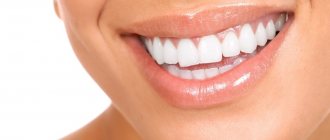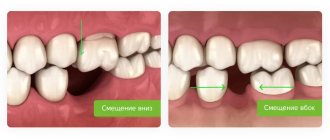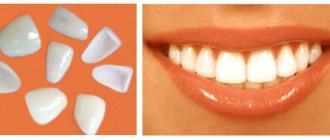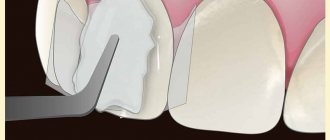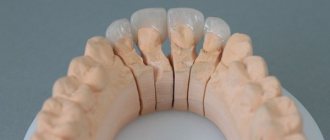Aesthetic (artistic) dental restoration
Artistic or aesthetic dental restoration is the reconstruction of a damaged tooth using composite materials. This treatment is carried out by a dentist-therapist specializing in aesthetic restoration.
To restore one tooth in the smile area (reason: chipped cutting edge, caries), the same composite light-curing materials are used as for filling. The tooth is restored by layer-by-layer application of materials. This technology makes it possible to almost completely reproduce natural enamel in color, transparency and strength.
Description of veneers
Veneers are generally porcelain or composite. These are thin shells that replace enamel in certain areas of the teeth. The dental restoration process is safe. This method of restoration is used to restore front teeth. This is the main indication for the use of this recovery method.
The main types of veneers include: Lumineers or Hollywood veneers. Their important difference is their sophistication.
The smallest thickness of veneers is 0.2-0.3 mm. The restoration can be precise and accurate. These devices can be divided by type and manufacturing method.
Popular by type of material:
- ceramic (porcelain) veneers, which are distinguished by the type of ceramic;
- pressed ceramics;
- aluminum oxide ceramics;
- zirconium oxide ceramics;
- composite veneers.
Dental restoration with inlays
If the tooth is severely damaged and most of the crown part is missing, the doctor will suggest restoration using a ceramic inlay. Inlays are created in a dental laboratory using an individual impression. These microprostheses are distinguished by the highest aesthetics and durability.
Advantages of inlays compared to conventional fillings:
- high resistance to external factors (do not change color even from drinking coffee);
- translucency, maximally imitating natural enamel;
- perfect shape, repeating in detail all the features of the destroyed part of the tooth;
- the possibility of shrinkage, which provokes the occurrence of hidden caries, is excluded.
Indications for use
To better understand what composite veneers are, the indications for their use will help. They are the same as ceramic veneers. The main indication is artificial restoration of enamel.
Dentists claim that they prepare such veneers for patients with signs of defective enamel: hypoplasia, aplasia, fluorosis, necrosis, tetracycline teeth.
These diseases can lead to complete destruction of the enamel. This results in an unhealthy color and an unaesthetic smile.
Direct composite veneers are used to hide or reduce the space between teeth (front teeth only). This will help hide unevenness and chips in the enamel. It is important to consider that this application will be relevant for correcting 1-2 teeth.
For more global problems, a different technique is used. Used in such cases:
- A chipped or sharp edge of a tooth.
- The space between the front teeth.
- The size does not match the shape of the plates.
- Injuries, as a result, changed their shape.
- Yellow or dark stains that are not removed by the bleaching process.
- Wedge defect.
- Premature aging and wear of enamel.
- Various pathological processes in periodontal tissues.
The technology for using composite veneers has been around for a long time. There is a wide range of veneers. They come in different strengths, wear life and colors. Their cost depends on this. This is also influenced by the technology of the procedure and the global extent of dental damage.
Direct veneers are universal and simultaneously solve all the problems mentioned above. You can install them in one go. It is worth noting that this procedure is not suitable for everyone and has certain contraindications. The main ones include:
- Global enamel defects not caused by caries. The classification is carried out taking into account the time of their formation. The first category is the period of pregnancy, the first teeth in children. The second category is the period when teeth begin to emerge.
- Loose teeth . This is one of the types of periodontal disease, which is accompanied by severe inflammation of bone tissue. This disease is treatable. Before installing veneers, the doctor prescribes periodontal treatment.
- Excessively weft enamel . It occurs against the background of bad habits (smoking), high consumption of sugar, and unhealthy diet. May have a genetic nature and individual characteristics.
- Rapid wear of teeth . This leads to the deformation of the crown shape.
- Bruxism . A disease that is accompanied by teeth grinding. This usually occurs during sleep. The patient must use a special dental guard. Otherwise, tooth damage and enamel wear occurs.
- Malocclusions.
- Caries.
Not all of these contraindications are categorical for the use of composite veneers. The patient undergoes a consultation with a dentist, who determines the treatment and the possibility of installing a veneer.
The techniques that doctors use in such cases are varied. Direct veneers have the advantage of not requiring complex manipulations . First of all, they don’t take impressions of your teeth. This saves time because the patient does not have to wait for the plate to be prepared.
Secondly, the installation of the veneer is carried out in 1 appointment. The procedure does not harm healthy teeth. Also, no anesthesia or dental glue is used.
It is worth noting that installing composite veneers is quite difficult. We can say that this is jewelry work. The doctor who performs it must have extensive experience. The patient does not experience pain or discomfort during the procedure. You can get a beautiful smile in just 1-1.5 hours.
Veneers can be removed at any time or corrections can be made. The procedure is carried out quickly and painlessly. Therefore, the patient should not be afraid to go to the dentist.
Professional hygiene and whitening
Modern aesthetic dentistry is unthinkable without professional dental hygiene. This procedure gets rid of plaque and tartar, returns the enamel to its natural shade, strengthening it, and is also an excellent prevention of caries.
Whitening is also an important aspect of aesthetic dentistry. Modern in-office whitening techniques (when the procedure takes place in the dentist’s office) make it possible to restore the whiteness of your smile in one session. The doctor may also suggest one of the home whitening systems.
Choosing the best veneers
Most doctors prefer to use ceramic onlays. Such devices can completely match the natural color and texture of living teeth. Ceramic veneers are produced in special laboratory conditions. They have high precision, which helps to adhere to the tooth surface as much as possible. Composite overlays do not have these properties.
Orthopedic pads are reliable. In addition, they reduce the risk of the appearance and development of caries. Bacterial infection often occurs in the space between the tooth and the artificial material. Therefore, the lesion may cause an ineffective restoration. Basically it all depends on the skill of the doctor. Before installing any device, the tooth must be thoroughly cleaned.
It is difficult to choose the best veneers . The doctor determines which pads to install, taking into account the individual case of each patient. To correct the aesthetic problem of one tooth, composites and ceramics are suitable.
Contraindications for ceramic veneers
Ceramic veneers can be placed on teeth from the moment when the permanent bite is fully formed, that is, for patients over 18 years of age. However, the decision to undergo veneering should always be balanced and deliberate. The general list of contraindications is as follows:
- Large fillings on front teeth
- Extensive carious lesions
- Gingivitis
- Periodontitis
- Malocclusions
Modern veneers in dentistry
Thick plates requiring serious tooth grinding are almost a thing of the past. A modern veneer is a very thin plate of durable ceramic, the thickness of which does not exceed 0.2-0.4 millimeters. Some veneers are almost as thick as eye contact lenses. Such a small thickness was achieved thanks to improved ceramic masses, which are highly durable. Now even a very thin veneer will not crack, unless, of course, you try to chew on a glass bottle or a piece of concrete.
Most often, veneers are classified as aesthetic dentistry because they allow you to perfectly adjust the color and shape of your teeth. However, veneer, being a microprosthesis, also solves functional problems - to hide chips and cracks in the enamel, to remove slightly enlarged spaces between teeth, to hide pigment spots. The veneer also serves as protection for the tooth, since ceramics are not subject to abrasion, unlike tooth enamel. It is much more difficult for plaque and bacteria to gain a foothold on ceramics.
Installing veneers can also significantly rejuvenate the face - they will restore the height of the teeth, like in young people, and will serve as a framework for the soft tissues of the face, which to a certain extent will prevent the appearance of wrinkles and sagging skin. However, if conventional veneers are so successful in the aesthetic and functional restoration of a smile, then why are refractor veneers needed?
Proper care
Once installed, composite or other veneers require careful care. You cannot bite hard food, limit traumatic effects and the influence of external factors. It is forbidden to bite foreign objects.
The patient must take good care of his teeth. Use toothbrushes, floss and irrigators. In addition, veneers need polishing. This procedure is performed by a dentist. Once every six months you need to undergo a doctor’s examination and, if necessary, make corrections to the composite veneer. With proper care, the service life of the linings will be long.
Indications and contraindications
Restoring teeth with veneers allows you to make your smile more beautiful and snow-white. The procedure allows you to get rid of complexes associated with dental defects.
There are the following indications for installing overlays:
- the presence of large chips that cannot be corrected with a filling;
- diastema;
- minor curvatures;
- disproportionate shapes of teeth;
- the presence of defects on the enamel.
Before agreeing to dentition correction, you should pay attention to contraindications to it. Veneers are not installed if the bite is incorrectly formed. It is also necessary to refuse overlays in the following situations:
- pathological abrasion of the dentition;
- lack of chewing teeth;
- bruxism;
- the presence of mobile and pulpless teeth;
- severe tooth decay.
Fans of extreme sports are not recommended to do veneering. When diagnosing periodontal diseases, appropriate treatment is first carried out, and only then cosmetic correction is carried out.
Installation principle
Since installing veneers requires grinding down the teeth, thin enamel can be an obstacle to the procedure. The thickness of the protective shell of the tooth should be normal. This is necessary in order to ensure reliable fixation of the plates.
Do your teeth hurt after getting veneers?
As we wrote above, if the installation of veneers was carried out efficiently, then pain should not bother the patient in principle. However, sometimes pain does occur. What can pain indicate after installation of veneers? Here are possible types of complications in which the patient may experience pain and discomfort:
- Individual reaction to low-quality fixative composition;
- Incorrect veneer size. Because of this, the microprosthesis can put pressure and injure sensitive gum tissue;
- High and unpleasant sensitivity after installation of veneers may occur in teeth from which too much enamel has been removed.
Eliminating all of the listed side effects will require both time and additional financial costs, and therefore it is so important that the installation of veneers takes place at all stages with strict adherence to technology!
Therefore, if you want the process of installing veneers to go without complications and you do not experience pain or other discomfort, you should always choose a clinic for the service carefully! Study reviews about the installation of veneers in Moscow in a specific clinic, find out about the reputation of its doctors and equipment.



